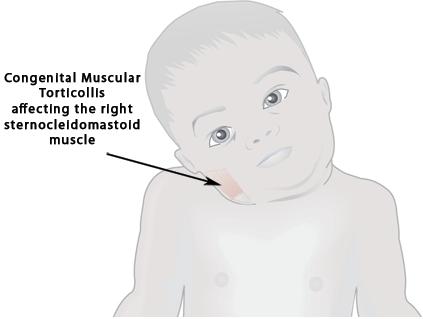
Congenital Muscular Torticollis, also referred to as Wryneck, is a stiff neck and presents with the baby’s head tilted to one side and rotated to the opposite side. The infant or child will demonstrate limited neck range of motion turning to one side usually. The muscles on either side of the neck called the sternocleidomastoid will spasm and shorten. Many times one or both of the baby’s occipito-atlantal joints (the joint between the head and the neck) are restricted or stuck making moving the head very difficult. Torticollis occurs in newborns due to positioning in utero, after a complicated vaginal delivery, a breech presentation, or use of forceps or vacuum devices. You may notice that your baby or child favors looking to one side only, has limited rotation of the neck, may sleep with the head turned to one side only, or has a small bump on the side of the neck which is the muscle spasm. The infant may also prefer to nurse on only one breast and have difficulty or “reject” the other breast just because the infant can not maintain the correct head, jaw, and neck position to effectively suck. This can lead to decreased breast milk production on that side, clogged ducts, mastitis, or nursing pain. Torticollis limits an infant’s or child’s ability to turn the head to see, hear and interact appropriately with his/her environment. Because of this, torticollis may lead to delayed cognitive development, delayed whole body awareness, weakness, and impaired balance. Although this disorder is not usually painful in infants it should be addressed as soon as possible by your pediatrician and treated by a skilled physical therapist. Left untreated can result in the baby’s head misshaping called positional plagiocephaly or asymmetrical molding of the head/face and may progress to scoliosis as the child grows.
How can Pamela Morrison Physical Therapy, P.C. help your baby with torticollis?
The expert therapists at Pamela Morrison Physical Therapy, P.C. will assess the severity of your infant’s or child’s torticollis by taking a birth and medical history and by performing a physical exam. Head molding will also be assessed. Gentle assessment of neck range of motion, neck muscle palpation for increased tone and spasm, mobility assessment of the occipito-atlantal joints, and developmental milestones observation will occur. Cranial bone alignment and cranial suture mobility will also be evaluated and corrected. Manual therapies such as joint mobilization, myofascial release, craniosacral therapy, integrative manual therapy, strain-counterstrain, and gentle stretching will be utilized to correct the torticollis. Guided and facilitated therapeutic exercises will help the infant/child increase their strength, achieve developmental milestones, improve their body awareness, improve their ability to see and interact with others and their environment, and help improve their balance. Positioning and stretching home exercises will be taught to the parents or guardian. A torticollis collar brace may be prescribed by your pediatrician.


